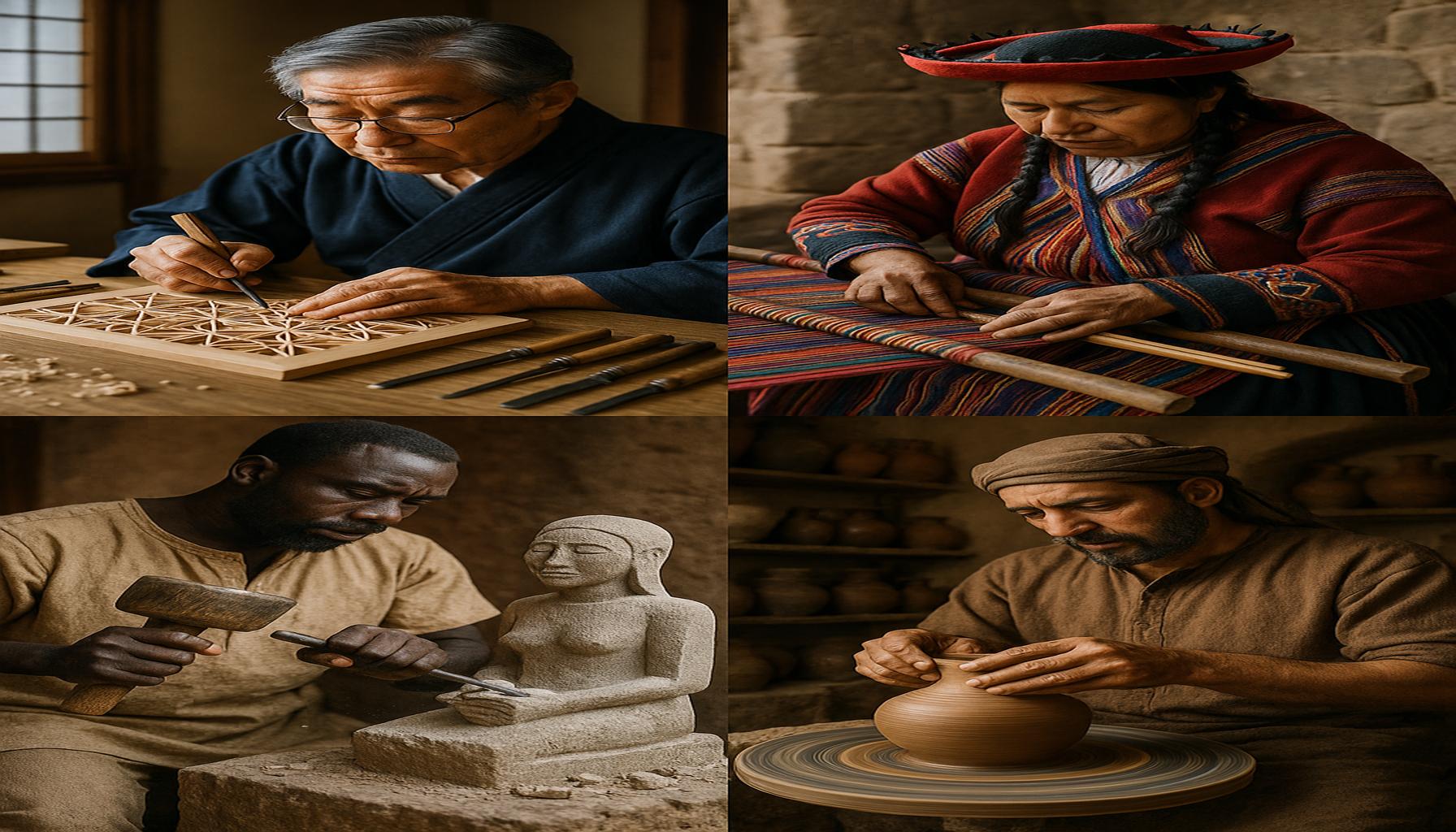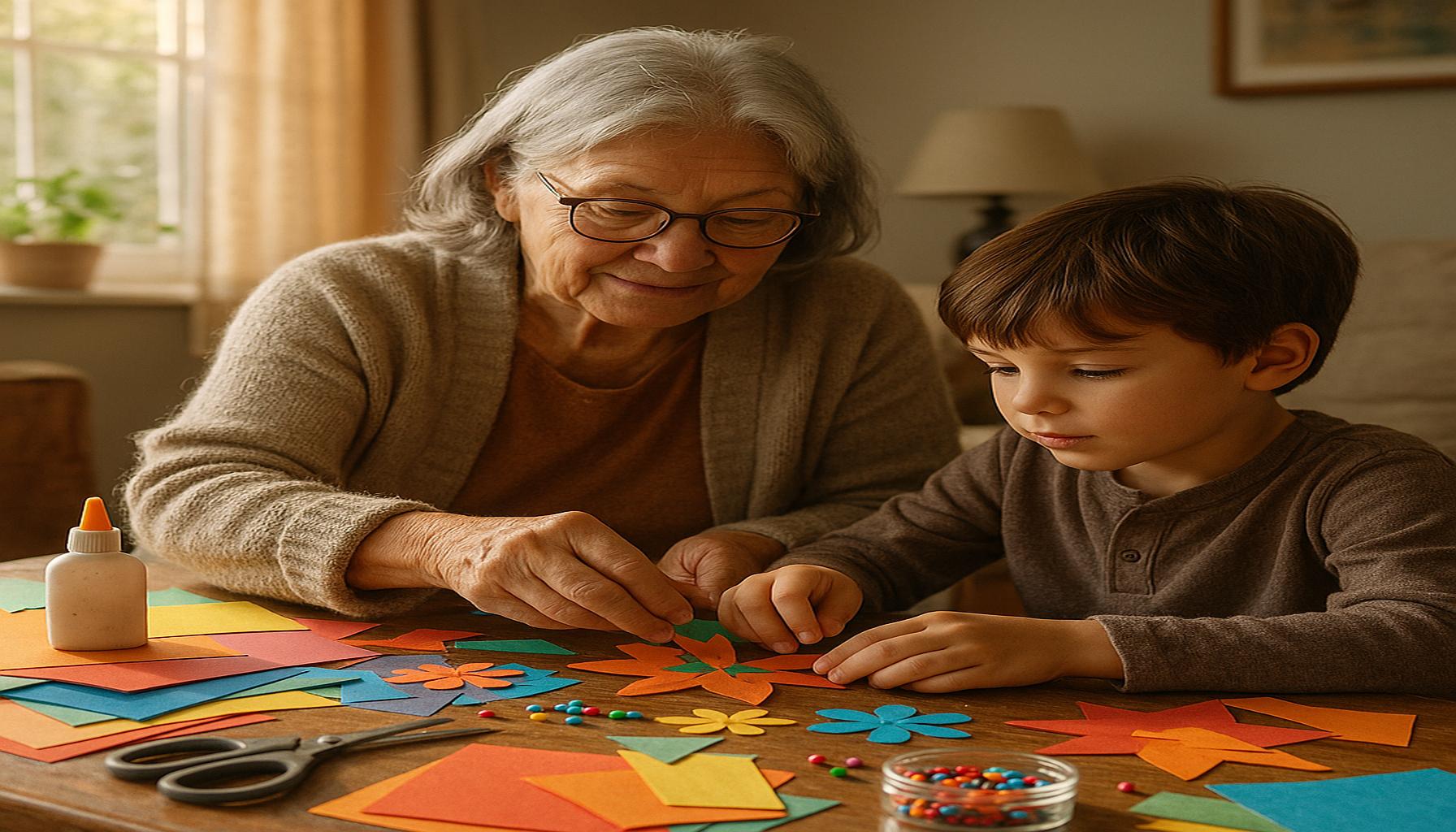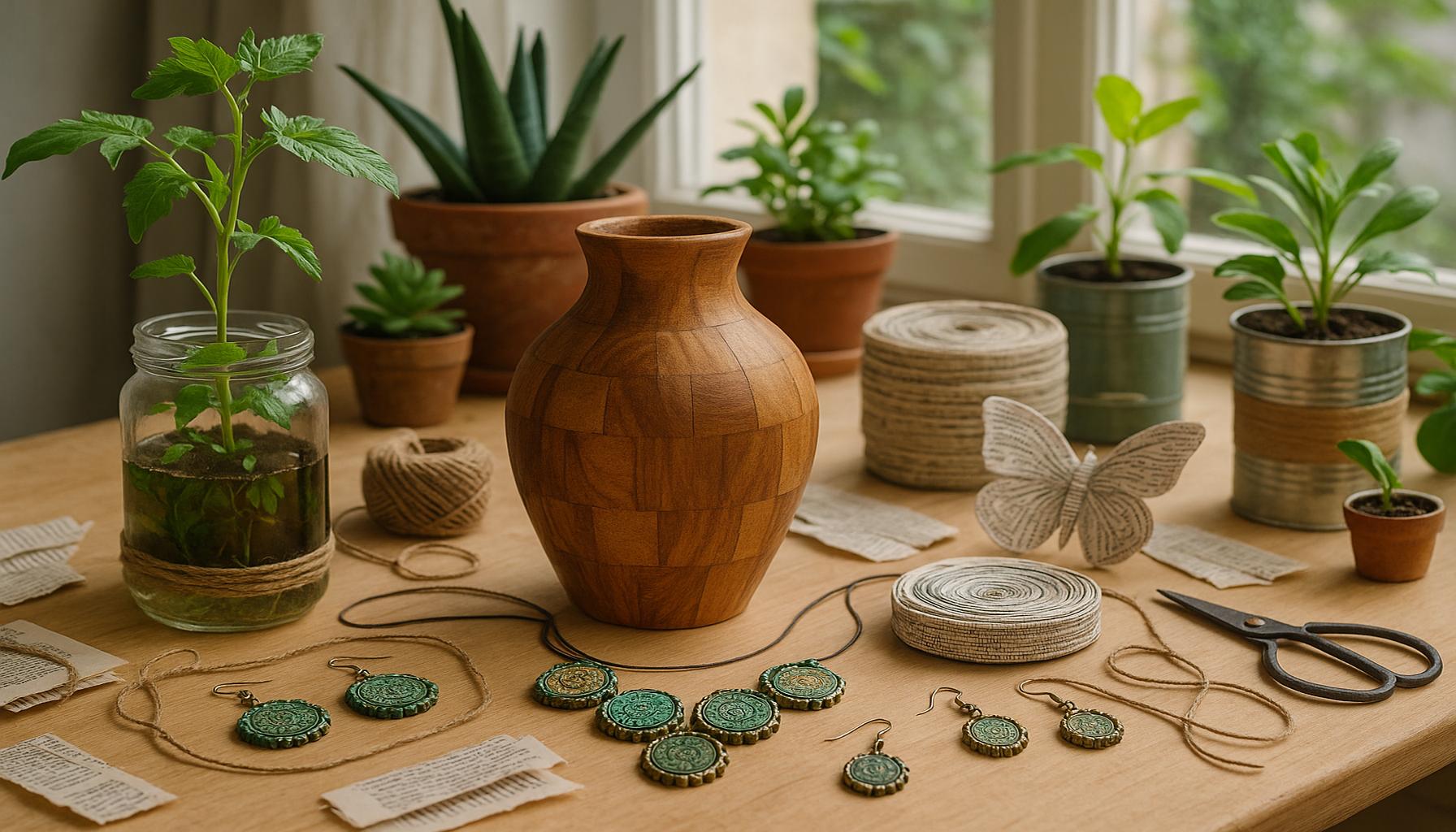Exploring Crafting in Different Cultures: Techniques and Traditions Around the World

Introduction to Cultural Crafting
Crafting is a universal language that transcends borders and reflects the unique essence of different cultures. From the intricate beadwork of indigenous tribes to the delicate techniques of Japanese origami, each craft tells a story. As we explore the myriad forms of crafting around the world, we will uncover the rich techniques and longstanding traditions that accompany them. Crafts are not merely hobbies; they are a means of expression, identity, and cultural preservation.
Textiles and Weaving
One area where cultural identity shines is in textiles and weaving. The vibrant patterns of Guatemalan huipiles showcase the rich heritage of Maya women, each design representing regional origins, beliefs, and social status. These colorful garments are hand-stitched using traditional methods that have been passed down through generations, each stitch telling a part of the weaver’s story. In contrast, the artistry of Persian rugs highlights the intricate designs and historical motifs rooted in the Middle East. These rugs are not only functional but also serve as significant cultural artifacts, often depicting tales of history and landscape.
Pottery
Pottery is another craft rich in cultural significance. The importance of Native American pottery cannot be overstated, as it serves both practical and ceremonial purposes within communities. Native artisans often use hand-coiling and natural materials like clay and pigments to create functional vessels that reflect their ancestry and spiritual beliefs. Similarly, the ancient techniques of creating Chinese porcelain demonstrate mastery in craftsmanship that dates back thousands of years. From the creation of blue and white wares to exquisite celadon, each piece is a testament to the technological advancements and artistic innovation of the time.
Metalwork
In the world of metalwork, the unique jewelry-making techniques in West Africa illustrate how crafting is intertwined with community and identity. Goldsmiths produce intricate pieces that often symbolize social status and tribal affiliations. Additionally, the historical practices of ancient Greek artisans serve as a fascinating study in how metalwork was imbued with mythological significance, with many pieces intended for religious ceremonies or as offerings to the gods.
The Role of Crafting in Culture
Cultural crafting not only showcases creativity but also serves as a vessel for community heritage. Every handmade item encapsulates traditions passed down through generations, reflecting local resources and environmental influences. Engaging with these crafts opens windows to the identities and values associated with various cultures.

- Social Connection: Crafting often fosters community bonds; artisans collaborate and share skills, forming networks that enhance both personal and community growth.
- Economic Impact: Many cultures rely on traditional crafts for income, promoting sustainability by utilizing local materials and techniques. This approach supports local economies and offers artisans a means to sustain their craft.
- Preservation of History: Crafts are vital in maintaining cultural identity in a rapidly globalizing world, serving as an anchor for traditions that might otherwise be lost.
As we embark on this exploration, prepare to uncover the hidden gems of crafting traditions that each culture proudly upholds. Join us on a journey through creativity, history, and the cultural significance woven into every crafted piece. From the vibrant colors of textiles to the delicate artistry of pottery, the world of crafting invites everyone to appreciate the stories behind each unique creation.
DIVE DEEPER: Click here to uncover the impact of music
Diving into Diverse Craft Techniques
The exploration of crafting across cultures reveals an abundance of techniques that are as varied as the cultures themselves. Each craft not only illustrates artistic expression but also acts as a keystone for cultural identity, offering insights into the values, beliefs, and histories of the artisans who create them. From the meticulous art of Japanese Sumi-e painting to the vibrant mosaics of Moorish Spain, the methods and materials employed highlight the distinct yet universal nature of human creativity.
Woodworking Traditions
Woodworking is an ancient craft that showcases the unique relationship between communities and their natural surroundings. Take, for example, the renowned Indonesian wood carvings. Artisans in villages like Bali create intricate designs that often depict local folklore, spirituality, and daily life. The vibrant details carved into a single piece of wood highlight not only the skill involved but also serve as visual storytelling that connects the community to its heritage. In contrast, the Native American totem poles, carved primarily from cedar trees, are steeped in symbolism and represent clans and family lineage. Each pole is a narrative tale that spans generations, with the storytelling ability of the woodcarver brought to life in form and shape.
Ceramics Across Continents
Ceramics serve as another captivating dimension in the world of cultural crafting. The rich tradition of Dutch delftware involves earthenware adorned with intricate blue and white designs, often inspired by Chinese porcelain, which was introduced to Europe in the 17th century. This fusion of creativity and adaptation speaks volumes about the interconnectedness of cultures. On the other side of the world, the Mexican Talavera pottery showcases vibrant colors and floral patterns, traditionally hand-painted using techniques that date back to colonial times. This craft not only highlights the artisans’ skills but is also a significant aspect of communal celebration and identity in Mexico.
Influential Jewelry Making
Jewelry making has a profound implication in cultural practices worldwide. In South Asia, the art of kundan jewelry involves setting precious stones within intricate gold settings—a technique that dates back to royal courts. These pieces are not merely adornments but symbolize wealth, beauty, and tradition. In contrast, the jewelry crafted by the Tuareg people of the Sahara is often made from silver, leather, and stones and serves as both personal decoration and cultural artifacts, defining tribe loyalty and status. The craftsmanship encapsulates a blend of tradition and personal expression, celebrating history through wearable art.
Global Crafting Techniques: A Summary
As we delve deeper into these distinct crafts, we recognize that each technique not only connects artisans to their cultural heritage but also promotes a sense of community and continuity. Here are some insights into the importance of crafting traditions worldwide:
- Cultural Significance: Crafts serve as an emblem of cultural identity, often portraying history, beliefs, and local customs.
- Skill Transmission: Many crafting techniques are passed down through generations, ensuring that traditional skills are preserved.
- Community Engagement: Crafting activities usually involve communal effort, creating bonds and fostering relationships among artisans.
By investigating various cultural crafting practices, we not only appreciate the beauty of artistry but also understand the importance of these crafts in conveying rich, diverse histories. As we continue to unravel the layers of crafting techniques globally, we will see how they converge, diverge, and evolve, contributing to an ever-changing landscape of artistic expression.
| Craft Technique | Cultural Importance |
|---|---|
| Indigo Dyeing | An ancient art form significant in many cultures, such as Japanese and Indian, where it represents heritage and identity. |
| Pottery Making | Unique clay techniques that tell a story about the geographical and historical context of a culture, enhancing the community’s connection to their land. |
| Weaving | Traditional weaving techniques from Peru to Africa showcase family traditions and are pivotal in passing down skills through generations. |
| Beadwork | In numerous Indigenous cultures, beadwork serves as a means of storytelling and spiritual expression, where each piece embodies unique meanings. |
Understanding these methods provides a glimpse into the rich tapestry of global artistry. Engaging with these crafts not only inspires individuals but also promotes cultural appreciation and the significance of traditional skills in contemporary societies. Each craft reflects the values, beliefs, and histories of the communities from which they originate, encouraging us to learn more about various cultural contexts worldwide.
DISCOVER MORE: Click here to unlock the secrets of vertical gardening
The Significance of Textile Arts
Textile arts form a vital part of global crafting traditions, serving both functional and artistic purposes as they embody cultural narratives. Techniques employed in textile crafting vary widely, reflecting the resources and historical context of each region, while simultaneously serving as a canvas for storytelling and cultural expression.
Elegant Weaving Techniques
The intricate art of weaving can be found across many cultures, and each has its own unique approach. In the Andean region of South America, the traditional craft of backstrap weaving has been practiced for centuries. Artisans skillfully use a loom that is secured to a stationary object, often their own body, to produce exquisite textiles that tell stories of their ancestry and cultural significance. The colors and patterns utilized often signify social status, regional identity, and personal stories, transforming cloth into a lasting legacy.
Meanwhile, the Japanese kimono fabric reveals a sophisticated technique known as Katazomeshi. Through intricate stenciling and dyeing methods, unique designs are achieved that reflect seasonal motifs and traditional designs. Each piece is not just clothing; it’s a representation of cultural heritage and often holds sentimental value, passed through generations.
Embroidery as Cultural Narrative
Embroidery can transform fabric into a storytelling medium, richly textured with meaning and artistry. The Bhutta embroidery of India, characterized by its vibrant hues and detailed patterns, is often featured on traditional garments and home decor. These designs usually convey themes of love, nature, or familial ties, making the craft an essential element of cultural identity.
Similarly, the Mexican embroidery traditions, such as the Tenango style, represent a vibrant fusion of history and art. While primarily associated with communal clothing such as the traditional Huipil, these textiles also serve to narrate the tales of the indigenous peoples of Mexico. Each stitch is deliberate, celebrating everyday life, folklore, and spiritual connections.
The Role of Crafting in Sustainability
Many crafting traditions are not only linked to cultural identities but also promote sustainability. In the Scandinavian region, the art of rag rug weaving exemplifies sustainability, where artisans reuse fabric scraps and textiles that would otherwise contribute to waste. This practice promotes an ethos of reusing and recycling, resonating with modern environmental movements while preserving artistry.
In Africa, techniques such as basket weaving utilize natural materials such as grasses, reeds, and twigs. These baskets are not only functional but are often sold at markets, providing economic support to artisans and their communities. Such practices underline the importance of creating crafts that honor both the environment and cultural traditions.
The Impact of Globalization on Craft Traditions
As globalization continues to reshape cultural landscapes, crafting traditions face both challenges and opportunities. Although there is a risk of commodification and loss of authenticity, there are also pathways for artisans to reach broader audiences, fostering exchange and collaboration. Many indigenous and traditional artisans are now utilizing online platforms to sell their crafts, allowing them to narrate their stories and connect with patrons worldwide.
- Cultural Resilience: Craft techniques often adapt to modern influences while maintaining their core significance, demonstrating the resilience of cultural identities.
- Economic Empowerment: Global markets offer artisans opportunities to elevate their crafts, often empowering communities and generating income through traditional skills.
- Cross-Cultural Exchange: Increased accessibility allows for cultural exchanges that enhance the diversity of artistic expression, enriching the global crafting landscape.
The exploration of textile arts and their significance underscores the intertwined nature of crafting and culture. Through weaving, embroidery, and sustainability, we gain a deeper appreciation for how traditions evolve, telling a timeless narrative reflective of humanity’s shared existence. This ever-evolving landscape of crafting traditions invites ongoing curiosity to understand not only the methods employed but also the stories they tell within different cultures.
DISCOVER MORE: Click here to learn about sustainable gardening
Conclusion: The Tapestry of Global Crafting
The journey through the diverse world of crafting techniques and traditions reveals much more than just the artistry involved; it highlights the deep cultural roots and the intricate relationships between communities, heritage, and sustainability. From the vibrant guatemalan textiles to the intricate Japanese kimono fabrics, each craft carries with it unique stories that articulate centuries of traditions, values, and environmental respect. With such rich histories behind every thread and stitch, crafting serves as a bridge connecting past and present, while reinforcing cultural identity.
The impact of globalization further enriches this narrative, as local artisans are empowered to gain visibility in international markets. This exposure not only fosters economic opportunities but also enhances the resilience of cultural practices, adapting them to contemporary influences without losing their essence. The prominence of sustainable crafting practices in various regions exemplifies how tradition can flexibly respond to modern challenges, reflecting a shared commitment to improving our relationship with the environment.
Ultimately, exploring crafting in different cultures is an invitation to engage with the stories behind handmade objects, urging us to appreciate not just the finished product, but the lives and communities shaped by these enduring traditions. As we celebrate this rich tapestry, we also encourage deeper exploration into the myriad crafting techniques from around the globe to uncover the hidden narratives woven into every piece. The next time you encounter a beautifully crafted item, remember that it is not simply a commodity, but a tangible connection to a vibrant cultural legacy.


